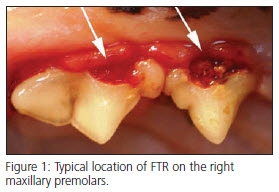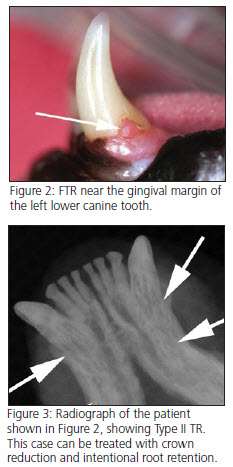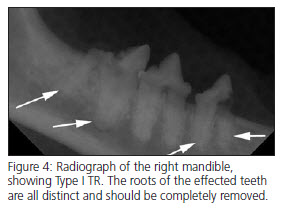 Malocclusion refers to abnormal positioning of the animal’s dentition. When malocclusion causes discomfort or interferes with normal function, it should be addressed. A common painful malocclusion seen in veterinary patients is Base-Narrow Mandibular Canine Teeth (BNMCT).
Malocclusion refers to abnormal positioning of the animal’s dentition. When malocclusion causes discomfort or interferes with normal function, it should be addressed. A common painful malocclusion seen in veterinary patients is Base-Narrow Mandibular Canine Teeth (BNMCT).
The normal position for mandibular canine teeth is the diastema between the maxillary third incisors and canine teeth, resting labial (lateral) to the maxillary gingival tissues. In BNMCT, the lower canine teeth occlude closer to the midline, commonly traumatizing the palate and causing painful ulcerated soft tissue lesions.
To demonstrate the patient’s discomfort with BNMCT, simply press the maxilla and mandible together firmly. The reaction of the patient leaves little doubt about the painful nature of this condition.
What Causes Base-Narrow Mandibular Canine Teeth?
BNMCT are associated with a variety of problems, including periodontal damage to the maxillary canine teeth, under-eruption of the mandibular canine teeth, reluctance to chew hard foods, class II  (overbite) malocclusion, development of ulcerated palatal lesions and oro-nasal fistulas. Effected mandibular canine teeth commonly impinge on the ulcerated areas during mastication. Some of these patient’s swallow their food whole. Puppies have very sharp cusp tips on their primary (deciduous) canine teeth that readily penetrate the palatal soft tissues (Figure 1). This may lock the maxilla and mandible into position and block any potential for self-correction of an existing class II (overbite) or Class III (underbite) malocclusion. When the dentition and/or soft tissues interact in a way that impedes the development of a normal maxillary/mandibular relationship, this is termed an “adverse interlock.”
(overbite) malocclusion, development of ulcerated palatal lesions and oro-nasal fistulas. Effected mandibular canine teeth commonly impinge on the ulcerated areas during mastication. Some of these patient’s swallow their food whole. Puppies have very sharp cusp tips on their primary (deciduous) canine teeth that readily penetrate the palatal soft tissues (Figure 1). This may lock the maxilla and mandible into position and block any potential for self-correction of an existing class II (overbite) or Class III (underbite) malocclusion. When the dentition and/or soft tissues interact in a way that impedes the development of a normal maxillary/mandibular relationship, this is termed an “adverse interlock.”
There are multiple causes for BNMCT. Abnormal tooth bud position and/or the angle of tooth eruption may contribute, and breeds with long narrow mandibles such as Shelties, Collies and Standard Poodles are commonly effected. Narrow mandibles, in conjunction with normal maxillary width, requires that the lower canine teeth to tip further labially (laterally) to achieve normal position. The lower canine teeth may be too short to reach a normal position when erupting from a narrow mandible. Class II (overbite) malocclusion causes a similar maxillary/mandibular width mismatch. The presence of base-narrow lower canine teeth may be seen as a solitary condition or in combination with other occlusal abnormalities.
Treatment of BNMCT in Primary Dentition
When identified in younger patients, treatment should be pursued as soon as possible to relieve discomfort and allow normal development of any disparities in the maxillary/mandibular relationship. Treatment options for base-narrow primary teeth include extraction or placement of composite tip extensions.
Extraction
The most common treatment in the past has been to simply remove the lower primary (deciduous) canine teeth, taking care to avoid damage to the unerupted permanent dentition. This mode of treatment does resolve the discomfort, but the permanent dentition usually erupts in the same base-narrow position, necessitating additional treatment for the problem at a later date. Extraction of the lower primary canine teeth results in correction and/or improvement in a small percentage of cases. Most patients treated in this manner will require some type of treatment after the permanent dentition has erupted. When extraction is selected as a treatment option, the surgery should be performed as soon as possible.
Simply amputating the crowns of the mandibular canine teeth results in painful exposure of the live nerve in the tooth and may allow infection to reach the developing permanent tooth. This practice is barbaric and should be avoided.
Every effort should be made to extract the entire root, as retained root fragments may deflect the permanent tooth into malocclusion or form sequestra that can last for many years. Dental radiographs are recommended to guide surgery and to demonstrate complete extraction of the entire root. For a complete review of primary canine tooth extraction, see the October 2011 newsletter, archived at www.wellpets.com, under information for veterinarians.
Composite Tip Extensions
 Another technique for the treatment of BNMCT involves the fabrication of composite tip extensions on the primary mandibular canines. This procedure provides immediate pain relief, allows normal jaw growth to occur, and usually results in normal occlusion in the permanent dentition. The technique involves the placement of labially (laterally) curved composite tip extensions on the lower primary canine teeth (Figure 2).
Another technique for the treatment of BNMCT involves the fabrication of composite tip extensions on the primary mandibular canines. This procedure provides immediate pain relief, allows normal jaw growth to occur, and usually results in normal occlusion in the permanent dentition. The technique involves the placement of labially (laterally) curved composite tip extensions on the lower primary canine teeth (Figure 2).
Note that the tip extensions are shaped to create lateral tipping forces on the primary canine teeth. Usually, after 10-14 days, the lower canines tip out and the rostral dentition closes into normal occlusion (Figure 3). When the primary lower canine teeth are eventually exfoliated, the attached composite appliances will be shed with the teeth.
After the primary canine teeth are shed, the permanent lower canines generally erupt along the path formerly occupied by the primary canines, resulting in normal occlusion for the permanent teeth. The author’s results on the first 20 patients treated with this technique show a 90% success rate with this procedure.
Figure 4 shows the permanent occlusion of the puppy treated in these pictures. While it is unrealistic to expect every patient to correct, this is far superior to the 10-20% success rate achieved with extraction alone. An additional advantage of this procedure is avoiding the risk of damage to the developing permanent dentition inherent to the extraction procedure.
Composite tip extensions are most effective when applied at an early age, any time after the base-narrow condition is recognized. Ten to twelve weeks of age is an ideal time for placement of the tip extensions. This allows adequate time for the alveolar bone to remodel around the new position of the primary canine tooth. Another criteria for case selection is that the lower canine be positioned in the diastemas in the rostral/caudal direction and not be trapped directly palatal (medial) to the upper canine teeth.
Download Newsletter (PDF)
Treatment Options for Base-Narrow Mandibular Canine Teeth: Part 2
Treatment Options for Base-Narrow Mandibular Canine Teeth: Part 3
